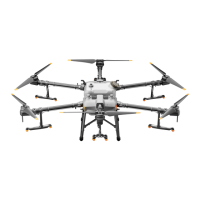Notice
1. Aircraft and battery performance is subject to environmental factors such as air density and temperature.
1. Be careful when flying 2 km (6,560 ft) or more above sea level as battery and aircraft performance may
be reduced.
2. DO NOT use the aircraft near accidents, fire, explosions, floods, tsunamis, avalanches, landslides,
earthquakes, dust, or sandstorms.
3. In low temperature environments (between 32° and 50° F (0° and 10° C)), make sure that the flight battery is
fully charged and be sure to reduce the payload of the aircraft. Otherwise, it will affect the flight safety or a
takeoff limit will occur.
Interference with Flight Controller and Communications
Notice
1. . Fly in open areas. Tall buildings, steel structures, mountains, rocks, or forests may affect the accuracy of the
on-board compass and block both GNSS and remote control signals
2. Avoid using wireless devices that use the same frequency bands as the remote controller.
3. When using with multiple aircraft, including T30, T10 and other aircraft, make sure that the distance between
each aircraft is more than 10 m to avoid interference.
4. The sensitivity of the radar module may be reduced when operating several aircraft within a short distance.
Operate with caution.
5. To avoid interference between operations, do not operate more than three groups within a 50 m radius when
using the Multi-Aircraft Control function.
6. Be alert when flying near areas with magnetic or radio interference. These include, but are not limited to, high
voltage lines, large scale power transmission stations or mobile base stations, and broadcasting towers. Failing
to do so may compromise the transmission quality of this product or cause transmission errors which may
affect flight orientation and location accuracy. The aircraft may behave abnormally or go out of control in areas
with too much interference.
7. If the RTK dongle is used for field planning, the module should be disconnected from the remote controller after
planning is completed. Otherwise, it will affect the communication performance of the remote controller.
Operating the Aircraft Responsibly
Warning
To avoid component malfunction, serious injury, and property damage, observe the following rules:
1. Make sure you are not under the influence of alcohol, drugs, or anesthesia, or suffering from dizziness, fatigue,
nausea, or any other conditions, whether physical or mental, that could impair your ability to operate the
aircraft safely.
2. DO NOT stop the motors mid-flight unless in an emergency situation where doing so will reduce the risk of
damage or injury.
3. Upon landing, power off the aircraft, and then power off the remote controller.

